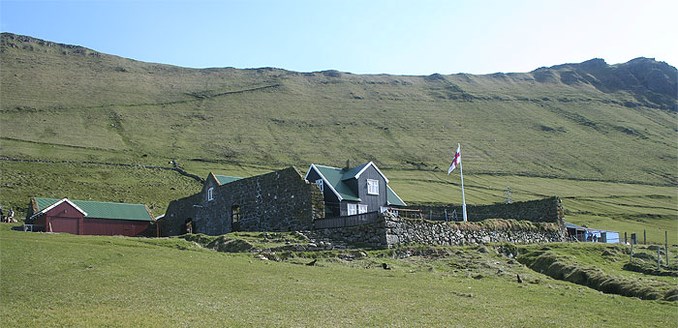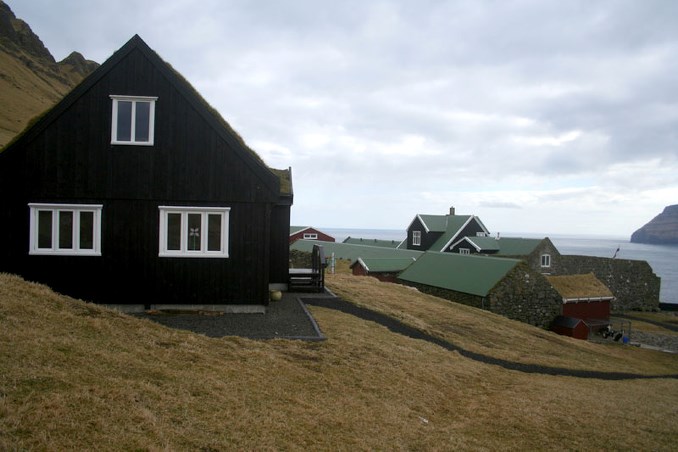
Facts about Stóra Dímun
Population: 7 (4 adults and 3 children)
Area: 2.65 km² (1,02 sq mi)
Highest elevation: 395 m (1,295 ft)
Postcode: FO-286
Coordinates: 61° 41' 49" N, 6° 44' 56" V
Main income:
Sheep farming
Secondary income:
Tourism, sheepskins and birds
Transportation: (by Helicopter)
Wednesday, Friday and Sunday
The farm's income comes mainly from sheep. We use almost everything from the sheep; we sell all the meat as well as the sheepskin (Press her to see the product).
The most valuable part of the sheep is the meat.
The sheep on Stóra Dímun are not among the largest on the Faroe Islands, but they are strong flavoured, very meat rich and very sought after.
Stóra Dímun is one of 18 islands making up the archipelago of the Faroe Islands. It is the smallest inhabited island in the Faroes, with 7 people living there all year round.

Daily life
People often ask, what we do on a daily basis and we often reply that essentially our daily routine isn't that much different from a typical routine.
We start the day early in the morning, as most people do. We all have our daily duties such as taking the children to school, making breakfast, lunch and dinner, followed by some housekeeping and so on.
Up in the Faroes, it's really nature that decides how our days unfold. However, our activities are primarily related to taking care of the livestock; sheep and cattle.
We often say that our year begins in the spring with the lambing season or "lembingin". During this period, our main task is to keep an eye on the sheep and their well-being.
Later in the summer, we focus our efforts into training the sheep and dogs, so that the sheep are easy to drive, or "reka".
During the summer we also get visits from tourists. Primarily, they come on one-day boat trips, where we typically walk down to the shore to welcome and guide them up onto the island, where they are served with refreshments. There is only one path up, and the same one path down this island, and it can be dangerous to embark on this walk if don't know where you are going. We do not recommend anyone to do it without a guide.
The lambs later have to be earmarked and receive their medication, and the ewes have to be sheared.
The grass has to be gathered as the summer draws to an end.
In September, we begin with slaughtering cattle. Typically we slaughter around 6 - 8 young bull.
Halfway through September is when the sheep slaughter starts. It usually takes around five to six weeks to slaughter the sheep, of which there are 400-450 on average. While this is the most exhausting period on the farm, it is at the same time a very exciting time, as we see the result of our hard work. Many people visit us during this period to participate and help us with the work.
During the winter, in addition to seeing to the maintenance of the buildings, we spend time tanning the sheepskin. We usually tan an average of 400 - 500 skins each year.
Before the lambing season begins, the sheep are driven inside, where they receive the medicine necessary for healthy lambing.
Early history
The first we know of Stóra Dímun, is from the "Færeyinga Saga". A book that was written in Iceland shortly after year 1200 AD and was later translated into Faroese. Færeyinga Saga is about the two brothers Brestir and Beinir, who where killed at Rakhella, which is located on Stóra Dímun.
It also describes the era when Øssur Leivsson ruled the island, who was killed in a revenge act by Sigmundur Brestisson for killing his father Brestir and his uncle Beinir.
Sigmundur Brestisson later became one of the most important people to have lived in the Faroe Islands. He was the man who brought Christianity to the islands. Sigmundur was sold as slave to Norway, when his father was murdered by Tróndur í Gøtu and his accomplices when Sigmundur was 9 years old. When he grew older, he became a great warrior and later on a chieftain for the Norse King Olaf Tryggvason.
The years following on from these events and up to 1600 AD, there is little mention of Stóra Dímun to be found.
Another noteworthy story is the one about Annika í Dímun, who killed her husband with poison so that she could live with one of the farmhands. The story ended in misery when she was betrayed by Sjúrður and was taken to Tórshavn and drowned as a punishment for her deeds.
There is also a story about a priest called Klæmint who owned Stóra Dímun. He was known for taking the land from others by cheating and betraying people for not upholding the church law, so that he, in the name of the church, could take their land.
In 1807, two brothers named Janus Olesen and Sørin Olesen moved to Stóra Dímun from Sumba. Their plan was to buy the island togethe, but Janus betrayed his brother and only signed his name on the island's deed. As a consequence, his brother Sørin had to leave the island and settled in Húsavík, a small village on the island of Sandoy.
Janus stayed in Stóra Dímun, and was the first generation of our family to reside here. We are now the 8th generation after Janus Olesen.

Visit Stóra Dímun - Fully booked
If you want to visit our wonderful island, it is now possible to rent a brand new 60m² cottage. In the summertime, the cottage is intended to be used only for tourists. From mid-August to mid-June, one of the rooms in the cottage functions as a classrom for the two children that live on the island.
Sleeps: 6-8 people
Amenities: There is fully equipped kitchen and a bathroom with a shower. The cottage also has satellite TV and WiFi internet.
Cost:
kr. 1000,- (135€) for the house per night.
kr. 100,- (13€) for an adult per night.
kr. 50,- (7€) for a child per night.
There is also a possibility to get a guided tour around the island by us.
Transportation to and from the island is by helicopter, 3 times a week.
Press her to see pictures of the cottage
